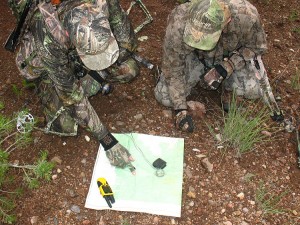July 26, 2012
By Patrick Meitin
 Some of you out there have no doubt drawn elk or mule deer or pronghorn tags far from home and will soon be heading west to chase your bowhunting dreams. In many cases you've never laid eyes on the area, leaving you wholly without a clue of where to start when you arrive. Yet there's no reason to arrive unprepared. It's easy to tip the odds of success in your favor, by engaging in desk-jockey scouting right now.
Some of you out there have no doubt drawn elk or mule deer or pronghorn tags far from home and will soon be heading west to chase your bowhunting dreams. In many cases you've never laid eyes on the area, leaving you wholly without a clue of where to start when you arrive. Yet there's no reason to arrive unprepared. It's easy to tip the odds of success in your favor, by engaging in desk-jockey scouting right now.
Sleuthing productive hunting country far from home starts by poring over maps of your chosen hunting area, quickly narrowing prospective hotspots. U.S. Forest Service, BLM, or U.S. Geological Survey maps get you into desolate areas effortlessly. Wilderness areas are prime suspects, but any large swatch of roadless terrain should raise a red flag. Some basic knowledge of the game and the habitat they prefer also proves useful. Poring over maps, especially topographical maps, gives you a better idea of what you're in for. Water's always important, most notably in drier portions of the West, so permanent creeks, springs, or even man-made drinkers or tanks, are of major interest.
Key contacts include US Forest Service, Bureau of Land Management (BLM), and US Geological Survey. Too, indexed to accurate topographical maps, today's GPS units can take you right in to remote spots, without worry of getting lost.
Next, seek people who might know something of the area you have in mind. State game and fish biologists often participate in aerial game surveys and can be quite helpful. Summer fire crews are often a great well of information, spending weeks in backcountry few trod, making a call to an area Forest Service office worthwhile. It's also often worth chatting up sporting goods employees near prospective hunting areas, getting the latest on recent weather conditions dictating where you hunt due to moisture or lack of.
Advertisement
Further research may involve referencing a state game department's annual harvest statistics. Hunt areas with success rates above 25 percent for deer, 30 percent for elk, and 50 percent on turkey are good places to start. Another good source of helpful information is the federal Natural Resources Conservation Service (formally Soil Conservation), who collects data on the flora and fauna found in particular areas across the nation. Their reports can lead to specific food supplies, water, and animal populations in a particular area. Get more info at www.nrcs.usda.gov/.
Another sometimes productive — and fun — way to scout is through on-line aerial photography web sites. TerraServer USA, GlobeXplorer, and US Geological Survey aerial surveys.
Scouting from home will never replace getting your boots on the ground, but the West is vast and narrowing prospects simply eliminates wasted time during limited vacation time. And you just never know — I've discovered some of my hottest hunting areas by carefully studying maps, at other times a tip from a conservation office biologist leading to a remote canyon or ridge where hunting proved exceptional.
Advertisement
